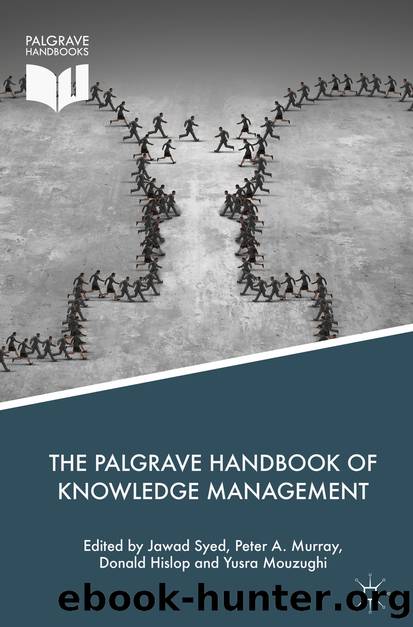The Palgrave Handbook of Knowledge Management by Jawad Syed Peter A. Murray Donald Hislop & Yusra Mouzughi

Author:Jawad Syed, Peter A. Murray, Donald Hislop & Yusra Mouzughi
Language: eng
Format: epub
Publisher: Springer International Publishing, Cham
Boundaries of Information and Knowledge-Sharing
Here we examine the boundaries of knowledge in the context of non-commercial organisations. We illustrate the boundaries of information-sharing in the case of Wikipedia. This website went up online in 2001 organised on the wiki principle that everyone can openly modify everything, anytime and anyhow. From a few hundred initial contributors, Wikipedia quickly grew and became the biggest wiki ever built. In its English version, as of the time of this writing it holds over 5 million articles and has more than 30 million contributors, of which approximately 134,000 are active every month. Claiming the production of encyclopaedic content , Wikipedia introduced a break with classical encyclopaedias, where an author had to be academically recognised to be entrusted with the drafting of an article. In the case of Wikipedia, even a first-year sociology student can edit the page corresponding to sociology. This has not failed to create several controversies about the reliability of the knowledge found there. Among all these works, Zhang et al. (2010) raise the question of whether the experts of a specific area are a source that is significantly used by wikipedians writing the corresponding pages. The methodology is based on a comparative survey of Wikipedia articles on terrorism, and a database of individuals, events and terrorist networks put together by professional analysts. Giles (2005) proposes a comparison between Wikipedia and Encyclopaedia Britannica on similar articles. Parallel to these discussions, Reagle (2010) offers a very detailed view of collaborative culture as the foundation of interactions between contributors. This latter work enables immersing ourselves in the daily interactions that produce and reproduce the wiki. We will put aside this discussion now in order to focus on how contributors build boundaries in the corpus of documents that they produce.
We briefly explore the project’s central concept, which replaces the notion of category in an encyclopaedia such as the Britannica. These projects at once provide separations but also powerful tools for drawing up boundaries. Wikipedia’s projects—or ‘WikiProject’—are local spaces dedicated to social construction of governance. For instance, the page ‘Wikipedia:WikiProject Economics’ lets us see a different regulation of contribution than the page ‘Wikipedia:WikiProject Philosophy’. Of course, this means that economics articles are not regulated the same way as those of philosophy. In that way, projects are more than the classical ‘category’, but at the same time, they are a regulation tool that allows different contributors interpret—and respect—the same rules differently.
Download
This site does not store any files on its server. We only index and link to content provided by other sites. Please contact the content providers to delete copyright contents if any and email us, we'll remove relevant links or contents immediately.
Hit Refresh by Satya Nadella(8328)
The Compound Effect by Darren Hardy(7545)
Change Your Questions, Change Your Life by Marilee Adams(6637)
Nudge - Improving Decisions about Health, Wealth, and Happiness by Thaler Sunstein(6629)
The Black Swan by Nassim Nicholas Taleb(6184)
Daring Greatly by Brene Brown(5636)
Deep Work by Cal Newport(5452)
Principles: Life and Work by Ray Dalio(5315)
Rich Dad Poor Dad by Robert T. Kiyosaki(5140)
The Myth of the Strong Leader by Archie Brown(4785)
Man-made Catastrophes and Risk Information Concealment by Dmitry Chernov & Didier Sornette(4728)
Big Magic: Creative Living Beyond Fear by Elizabeth Gilbert(4718)
The Slight Edge by Jeff Olson(4716)
Discipline Equals Freedom by Jocko Willink(4631)
The Motivation Myth by Jeff Haden(4521)
Digital Minimalism by Cal Newport;(4511)
Stone's Rules by Roger Stone(4412)
Management Strategies for the Cloud Revolution: How Cloud Computing Is Transforming Business and Why You Can't Afford to Be Left Behind by Charles Babcock(4127)
The Doodle Revolution by Sunni Brown(4034)
